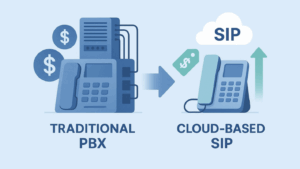
Understanding SIP Trunk Capacity: Concurrent Call Limits
If you’re wondering, “How many SIP trunks do I need to keep my business running smoothly,” you’re not alone. Whether you’re managing a high-traffic call center or a small office with occasional outbound calls, figuring out the right number of SIP channels is key to balancing call quality, cost savings, and future growth. With today’s communication systems relying more on internet protocol and less on traditional phone lines, understanding SIP trunk capacity is essential.
In fact, 65% of companies have already moved away from legacy telephone networks in favor of internet telephony service providers. The main driving force is benefits like scalability, reduced physical hardware, and unified communications. But as with any technology upgrade, success depends on planning. Knowing your concurrent call volume, your provider’s service level agreement (SLA), and your network’s bandwidth are all part of the equation. This guide breaks it all down—minus the jargon—so you can make informed decisions about your SIP trunking setup.
What is SIP Trunking?
SIP, short for Session Initiation Protocol, is the technology behind modern internet-based phone systems. It allows voice traffic to travel over the internet as digital data, much like how emails or video calls are transmitted. Instead of relying on old-school telephone lines, SIP trunking establishes a virtual connection between your phone system and the public switched telephone network (PSTN).
SIP trunking is flexible. Rather than being locked into the limitations of physical hardware or PRI lines, your calls run over a reliable internet connection. You can scale up or down easily, adding or removing SIP trunk channels based on your current call volume or business needs.
Businesses relying on SIP trunking can support multiple calls simultaneously and manage communication systems across multiple locations. Whether you need one SIP trunk or dozens, it’s all handled digitally without the hassle of traditional copper wiring. For businesses looking to future-proof their phone systems, SIP trunking offers a smarter, more scalable way to stay connected.
How Many SIP Trunks Do I Need?
Figuring out how many SIP trunks your business needs depends on how your team communicates. A good rule of thumb is to plan for one SIP channel (or line) per concurrent call. For example, if you typically have 10 people on the phone at the same time, you’ll need 10 SIP trunk channels. But that number can shift depending on your company’s size, peak call times, and the type of work you do.
Some businesses can get by with a single SIP trunk supporting a few channels, while others (like contact centers or multi-location enterprises) may require more SIP trunks and higher call capacity. The goal is to ensure every outbound or inbound call goes through without a busy signal or service interruption.
Of course, before locking in your configuration, consider the factors that affect SIP trunk capacity, from bandwidth and codecs to your provider’s reliability and SLAs.
Factors Influencing SIP Trunk Capacity
SIP trunk capacity isn’t just about how many calls you can handle at once; it’s about how well your communication system performs under real-world conditions. From bandwidth to audio quality to service reliability, several technical factors work together behind the scenes to support every call your business makes or receives. Let’s walk through the essentials so you can better understand what shapes your system’s performance and how to plan for smooth, high-quality conversations.
Bandwidth: The Backbone of Call Quality
Think of bandwidth like a highway. The more lanes (bandwidth) you have, the more cars (calls) can travel without running into traffic jams. If your internet connection doesn’t have enough bandwidth, your calls could end up sounding choppy or might not go through at all.
Ensure your internet connection can handle your call volume, especially during peak hours. A good starting point is understanding that each SIP trunking channel requires about 85–115kbps of internet bandwidth, depending on the codec used.
And it’s not just phone calls you need to consider. Many SIP trunking setups also support video conferencing, messaging, and real-time data sharing, all of which place additional demands on your network. If you’re using SIP for unified communications across multiple devices or locations, it’s worth factoring in those extra layers of bandwidth usage to avoid service interruptions.
Choosing the Right Codec for Your Call Needs
Codec stands for coder-decoder. It’s the technology that converts your voice into digital signals and back again. Some codecs use more bandwidth but offer higher quality (like G.711), while others are more compression-friendly (like G.729), using less bandwidth at the cost of some quality. Choosing the right codec can be a balancing act between call quality and bandwidth usage.
Compression: Balance Quality and Efficiency
Compression helps reduce the amount of data each call uses, making it easier to send voice traffic over your internet connection. It’s like zipping a file to make it smaller and faster to transfer. But just like overly compressed videos can look pixelated, too much compression can hurt call quality, leading to muffled audio or delays that frustrate both your team and your customers.
To strike the right balance, consider how much bandwidth your network can consistently provide. If you have a strong, reliable internet connection, you may prefer a high-quality codec with minimal compression, like G.711. On the other hand, if you’re working with limited bandwidth or supporting multiple locations, a more efficient codec like G.729 may make sense as long as you’re prepared for a slight dip in audio clarity. Your SIP provider can help you test different settings to find the sweet spot between sound quality and network efficiency.
Why a Strong SLA Is Your Safety Net
Your SIP trunk prover’s SLA outlines the expected performance and reliability of your service. This can include uptime guarantees, call quality, and what happens if the service doesn’t meet the agreed standards. A strong SLA can give you peace of mind, knowing that your provider is committed to maintaining the high level of service your business relies on.
How Many Concurrent Calls Can a SIP Trunk Handle?
There’s no fixed number of calls a SIP trunk can handle. It all depends on your setup. Factors like bandwidth, trunk configuration, and your provider’s flexibility influence how many calls can happen at once. Rather than thinking in absolutes, it’s better to evaluate your specific needs based on available resources and usage patterns.
Here’s what impacts your concurrent call capacity:
- Bandwidth availability: Each SIP call uses a portion of your internet connection. A 10Mbps connection could technically support 80–100 simultaneous calls, but keep in mind that other online activity (streaming, downloads, VPN, etc.) will reduce that number.
- Scalable trunking options: Many providers offer elastic SIP trunking, which automatically scales your channel capacity up or down in real time based on call volume. This prevents busy signals and helps avoid overpaying for unused capacity.
- Network prioritization and QoS: Call quality suffers when voice traffic competes with other high-traffic applications. Quality of Service (QoS) settings in your router can help prioritize voice packets so more calls stay clear and uninterrupted.
The bottom line? Your SIP trunk’s concurrent call capacity is closely tied to your internet connection and how intelligently your system is configured. Planning ahead for your peak usage and working with a SIP trunking provider that supports elastic scaling can keep your calls running smoothly without paying for more channels than you need.
Calculating Your Business’s SIP Trunk Needs
Once you understand how SIP trunk capacity works, the next step is figuring out how that applies to your own setup. Every business has a unique communication footprint. Some handle steady, low-volume traffic while others deal with unpredictable spikes throughout the day. To right-size your SIP trunking solution, consider a few key variables: how your team uses the phones now, when usage peaks, and where your business is headed next.
Expected Call Volume
Start by taking a close look at how your team uses the phones day to day. Are calls spread out across departments or concentrated among a few high-traffic users like sales or support? You don’t need a one-to-one match between employees and SIP channels. Most businesses find that one channel for every three to four employees is a reasonable baseline.
That said, this ratio can shift depending on your communication habits. A customer service team might need more simultaneous call capacity than an accounting department, for example. Reviewing your call logs or analyzing past usage trends can give you a clearer picture of how many concurrent calls you typically handle. The goal is to plan for realistic, not theoretical, usage. That way, you’re covered when it counts without overspending on unused capacity.
Peak Hours
Your SIP trunking setup should be built for your busiest moments, not just the daily average. Identify when your highest call traffic occurs, whether it’s early mornings, late afternoons, or during specific days of the week. These spikes are when dropped calls or busy signals are most likely to hurt customer satisfaction and productivity. Planning your channel count around peak usage ensures your system holds up under pressure and avoids unnecessary strain on your communication flow.
Future Growth
Planning for the future is just as important as understanding your current needs. As your business grows, so will your communication requirements. Consider how your call volume may increase, and plan your SIP trunk capacity accordingly. Foresight will save you from the hassle of constantly adjusting your setup and ensure that your communication infrastructure can scale with your business.
Optimizing SIP Trunk Capacity for Your Business
Making sure your business communication runs smoothly over SIP trunks involves more than just setting them up. It’s about ensuring the quality and reliability of your calls. Here’s how you can optimize your SIP trunk capacity effectively.
Quality of Service
QoS makes sure important calls get priority over other internet traffic, like emails or file downloads. This means your voice data reaches its destination without delay or distortion. Setting up QoS can significantly improve call quality, especially during peak internet usage times.
Separate Internet Connection
Sharing bandwidth between voice and data can lead to inconsistent call quality, especially during heavy internet use. One way to avoid this is by setting up a dedicated internet connection solely for your VoIP traffic. By isolating your SIP trunking from general network activity like video streaming, large file transfers, or cloud backups, you create a clear path for voice data to travel uninterrupted. You can ensure consistent call clarity and reduce the risk of jitter, latency, or dropped connections during peak hours.
VPN for VoIP
Using a Virtual Private Network (VPN) for your VoIP traffic can enhance security and potentially improve call quality by providing a stable route for your SIP traffic. This is particularly useful if you have remote workers or multiple office locations. A VPN ensures your calls are encrypted and secure.
Network Health Check
Your network is the foundation of your SIP trunking performance, so it pays to keep it in top shape. Routine health checks can help you catch issues like packet loss, latency, or misconfigured firewalls before they start affecting call quality. VoIP-specific monitoring software can help visualize your network’s performance and spot bottlenecks.
Many SIP trunking providers also offer guidance or resources to help you assess and optimize your network. Whether it’s helping configure your router for VoIP traffic or recommending best practices for SIP-friendly firewall settings, a responsive provider can be a valuable partner in keeping your communication system running smoothly.
Frequently Asked Questions about SIP Trunk Capacity
What is the difference between SIP trunking and VoIP?
While both SIP trunking and VoIP involve making calls over the internet, they’re not the same. VoIP (Voice over Internet Protocol) is a broad term that covers any phone calls made over the internet. SIP trunking, on the other hand, is a specific method used to enable VoIP calls by connecting your PBX to the internet.
Can I adjust the number of channels on my SIP trunk?
Yes, you can! With SIP trunking’s flexibility, you can add or remove channels as your business needs change. Scaling up during busy seasons and down when things are quieter ensures you’re not paying for more than you need.
Right-Size Your SIP Trunking for Better Business Communication
Choosing the right SIP trunk capacity is about building a flexible, future-ready communication system that grows with your business. From evaluating bandwidth to understanding how many SIP trunks you need, every detail plays a role in keeping your team connected and your customers happy.
At SIP.US, we make it easy to find the right fit. Our scalable, contract-free SIP trunking services let you adjust on the fly, and our self-service control panel puts you in charge of your system. Whether you’re a small team or managing multiple locations, we’ve got the tools, flexibility, and support to help you stay ahead. Get started today with a free trial and experience the difference for yourself.



